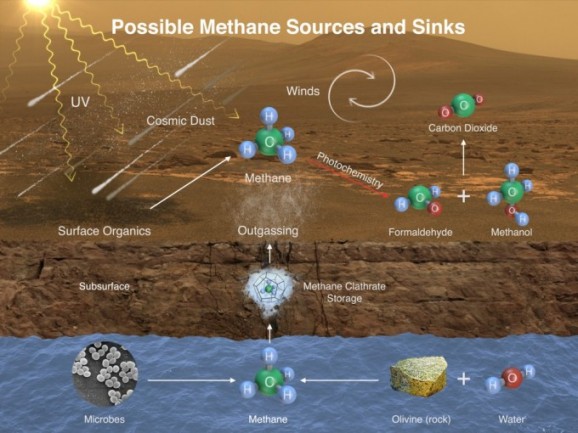Oxygen Discovered On Mars, The Evidence For Martian Life Is Mounting
This could be it, folks. The evidence for life on Mars is mounting—it’s still circumstantial at this point, but every new discovery and every tantalizing hint gets us closer
This article is more than 2 years old

This could be it, folks. The evidence for life on Mars is mounting—it’s still circumstantial at this point, but every new discovery and every tantalizing hint gets us closer to answering the million (billion?) dollar question: did life ever exist on Mars? And the obvious follow up question: does life exist on Mars right now?
This week the European Space Agency’s ExoMars Trace Gas Orbiter spotted Mars’ upper atmosphere emitting a greenish glow. All the current evidence suggests that this greenish glow is due to the presence of oxygen in the Martian atmosphere. Such a glow happens on Earth when oxygen molecules from our atmosphere are excited by sunlight.
That doesn’t mean Elon Musk will be able to walk around on Mars without a space suit when he gets there, as while there is oxygen it’s probably not enough to sustain human life. But if Oxygen can be filtered directly from the planet’s atmosphere it would make living there a lot easier. It also raises the possibility that life may have existed on Mars in the past and, perhaps, may even secretly live there hidden away somewhere.
The Evidence For Life On Mars Is Mounting
In addition to the discovery of oxygen on Mars, in 2014 scientists found surprising and fluctuating methane emissions on the Red Planet. Sure, there are a few possible explanations for the methane, but one of them is that it comes from something biological—i.e., Martians. Probably only microbial ones, but still. This is a seriously big deal.
As you might know, Curiosity Rover’s time on Mars culminated in its journey to Mount Sharp, where examined rocks and soil buried deep below the mountain’s surface. Mount Sharp is located in Gale Crater, which scientists now know used to have a bunch of lakes, rivers, and deltas, and seems like a pretty good spot to foster some kind of life. But life is tough to find, especially when you’re not exactly sure what you’re looking for. Martian meteorites have been found to contain organic compounds, but scientists still can’t say with certainty that they prove the existence of past life on Mars. So Curiosity keeps looking. One of the best ways scientists know of to hunt for life is by studying methane emissions (one of the gases responsible for the greenhouse effect).

Curiosity monitored methane levels at Gale Crater over a few months, and the readings have baffled scientists. As noted in a paper published in Science, Mars’ methane levels spiked, increasing by about ten times, and then ebbed back to usual. They don’t know what has caused these methane emissions, or the variations between them. Right now, scientists have three different theories:
1. That surface organics have caused the methane emissions during interactions between solar radiation and the Martian dust and soil.
2. That the methane comes from geological processes, which happens on Earth as well. When certain minerals interact with water, which we know Mars has, they produce methane.
3. That the methane comes from biological processes, probably from microbes that produce the emissions as they metabolize nutrients.
Scientists are understandably excited by the prospect of the third possibility, but they’re being rational and measured in their response. One of the authors of the study, NASA’s Paul Mahaffy, says, “All we can really do is lay out the possibilities. And we certainly should have an open mind. Maybe there are microbes on Mars cranking out methane, but we sure can’t say that with any certainty. It’s just speculation at this point.”
What we do know is that the methane readings are fluctuating a lot. The average level is .7 parts per billion, which is more than the readings Curiosity obtained last year. The earliest measurements from Curiosity found no methane at all, which disappointed many scientists, but turned out to be only the beginning of this investigation.
The fluctuations could be caused by methane stored in the planet’s surface, which then escape through cracks, but at an inconsistent rate. Scientists believe the escaped methane gets carried by planetary winds and is eventually broken down and converted into carbon dioxide, which comprises the bulk of Mars’ atmosphere. They speculate that the source of the methane is “small” and “localized,” and may suggest that “Mars is currently active.”
I can only imagine how exciting this must be for people working on the project. I hope it’s not long before we have direct evidence of life on Mars, either past or present. Then, of course, the big questions will be about the future of life on Mars, but Curiosity won’t be able to dig up those answers.












